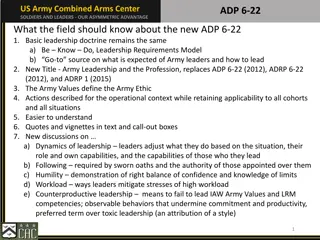Management and Leadership: Understanding the Differences and Functions
Explore the distinctions between managers and leaders in various contexts such as sports, music, politics, education, and work environments. Understand the definitions of management and leadership, including Management by Objectives (MBO) and the impact on motivation and productivity. Discover how managers set objectives and make decisions while leaders inspire and motivate to achieve goals.
Download Presentation

Please find below an Image/Link to download the presentation.
The content on the website is provided AS IS for your information and personal use only. It may not be sold, licensed, or shared on other websites without obtaining consent from the author. Download presentation by click this link. If you encounter any issues during the download, it is possible that the publisher has removed the file from their server.
E N D
Presentation Transcript
A1 Are managers and leaders the same? DEFINITIONS OF MANAGEMENT AND LEADERSHIP Think of examples from the worlds of: Sport Music Politics School/college History Part time jobs/work experience LEARNING AIM A: THE DEFINITIONS AND FUNCTIONS OF MANAGEMENT
DEFINITIONSOFMANAGEMENTAND LEADERSHIP In this topic you will learn about Management by objectives Situational and contingency Functional and action centred Transformational and transactional The concept of leadership continuum for management behaviour
MANAGERSANDLEADERS Leadership is the ability to influence and direct people in order to meet the goals of a group Management is the process through which company resources are used and decisions made in order to meet the objectives of the firm Leaders are those people that can inspire and motivate people to meet objectives Managers will set objectives and decide how to go about achieving them Often leaders and managers are one and the same person
MANAGEMENTBYOBJECTIVES Superiors and subordinates work together to set objectives as a collective Objectives are then broken down into targets for specific functions and individuals Involvement in the setting of objectives creates a common focus and greater support for the objectives This generates an team spirit making it easier and quicker to achieve the objectives Motivation is higher leading to greater productivity and efficiency However, the process can be time consuming, requires careful coordination and can generate conflict A tug of war can arise between leaders, managers and employees when objectives are being set
MANAGEMENTBYOBJECTIVES Aims to increase motivation by sharing the overall business objective between groups of employees so that everyone has departmental targets that will contribute to the overall success of the business The effectiveness of MBO is dependent upon the way in which managers handle the setting and communication of targets Advantages Disadvantages Provides a clear focus for all managers and employees Time consuming process to set, monitor and review objectives Gives a sense of belonging and worth Workers may feel demotivated if objectives are unrealistic Everyone focussed on the same goal
CLASSDISCUSSION Consider the role of a teacher in 4 different situations Infant or primary school Secondary school Sixth form University Does a teachers leadership style vary depending upon the situation? If so why? Can it vary even within the same stage of education e.g. a year 7 class and a year 13 class? If so why? Why can t the same style be adopted in all situations?
SITUATIONALANDCONTINGENCY In what situations should your head of school or college be autocratic and tell everyone what to do? Situational leadership theory starts from the premise that the most appropriate leadership style depends on the situation i.e. different tasks require different leadership styles In what situations should they be democratic and discuss the best course of action? Good leaders therefore need to be able to adapt This comes form education, experience and willingness to take responsibility Comes from the Hersey-Blanchard Situational Leadership Theory
SITUATIONALANDCONTINGENCY There are 4 levels of maturity M1 M4 M1 Basic incompetence and unwilling M2 Inability but willing M3 Competent but lacks confidence in ability M4 Ready, willing and able An individual may be M3 overall but M1 in relation to specific tasks Can you think where this might relate to you, maybe in an area of college work or interest? Can you think of an area where this applies to a sports person or performer?
SITUATIONALANDCONTINGENCY This can be translated into 4 competency and commitment levels D1 D4 Competence Commitment D1 Low Low D2 Low High D3 High Low D4 High High A leader who understands their subordinates will then be able to select a leadership style and adapt accordingly
SITUATIONALANDCONTINGENCY The theory outlines 4 basic behaviours of leaders S1 Telling Communication is 1 way Leader tells the group what will be done, how and when by S2 Selling Some 2 way communication Leader is clearly in charge but discusses what needs to be done and the merits of the actions to be taken S3 Participating 2 way communication Leader shares the decision making process with the group in a democratic manner building employee : employer relations S4 Delegating 2 way communication Leader monitors decision making but allows some autonomy for specific tasks
ACTIVITY In pairs take it in turns to explain one of the leadership behaviours shown in the diagram below. Support your explanation with examples of when appropriate.
FIEDLERSCONTINGENCYMODEL There is no one style of leadership that is best it depends on the situation Model based on his study of the personality and characteristics of leaders 2 factors need to be considered: The leadership style The situation (situational favourableness) Step 1 is to identify a leaders fixed style in terms of whether they are relationship or task orientated Step 2 is to identify the situation in terms of level of trust in team, degree of structure and relative power within the team
SITUATIONALANDCONTINGENCY Fielder s contingency theory of leadership Think of a task where you are to be the leader either at school or college or at work. You could assume your next assignment is a group task and you are to be the team leader. Contingent means dependent. Therefore, like situational theory this argues that there is no correct style of leadership It is contingent or dependent upon the situation Follows 3 steps: Use the link below to follow the 3 steps to identify the most effective leadership style. Step 1 Identify own leadership style Relationship orientated or task orientated This is done using the Least Preferred Co-worker scale Step 2 Identify the situation Step 3 Determine the most appropriate leadership style
FUNCTIONALANDACTIONCENTRED John Adair s Action Centred Leadership Leadership should be defined by what leaders do Leaders need to balance 3 elements Task As you watch this video clip make additional notes on action centred leadership. Team Individual Leaders have 8 functions Defining the task Planning Briefing the team Controlling Discuss how each function links to each element. Evaluating Motivating Organising Setting an example
TRANSFORMATIONALANDTRANSACTIONAL Work in pairs to decide whether each point in the middle column relates to transactional or transformational leadership. Transactional Transformational Focuses on day to day tasks Proactive Strives to achieve the next level of performance Thinks beyond the day to day tasks to develop future strategies Uses rewards and punishments to motivate Uses team building, motivation and collaboration Maintains normal operations keeping the ship afloat Transformational v. transactional Sets goals and incentives incl. opportunities for personal and professional development Reactive Exchanges rewards for performance
TRANSFORMATIONALANDTRANSACTIONAL Use the diagram below to explain the difference between transactional and transformational leadership
THECONCEPTOFLEADERSHIPCONTINUUM FORMANAGEMENTBEHAVIOUR The concept of leadership continuum for management behaviour can be explained using: The Tannenbaum Schmidt continuum Leadership model based on a spectrum between two extremes of manager centred and subordinate centred approaches Recognises that in reality leaders are unlikely to be at either extreme but somewhere along the spectrum
TANNENBAUM SCHMIDTCONTINUUM The Continuum Theory looks at 7 levels of delegation from: 1 no delegation to 7 highly delegated
TANNENBAUM SCHMIDT CONTINUUM Why might a leader change their style based upon the situation? Manager takes and announces decisions Manager sells decision Manager presents decision with ideas and invites questions Manager suggests provisional decision and invites discussion Manager presents the situation, gets feedback and then decides Manager explains, defines parameters and asks team to decide Manager allows team to develop options and decide on action based within managers limits 1. 2. 3. 4. 5. 6. 7.
TANNENBAUM SCHMIDTCONTINUUM From this continuum there are four categories of leadership identified: Sells Tells Consults Participates Discuss each of the points 1 7 along the continuum. Allocate numbers to each of the 4 categories above. With reference to the continuum explain each of the 4 categories in your own words.
TANNENBAUM SCHMIDTCONTINUUM The approach that the manager will adopt will vary and depend upon: The forces in the manager Personality and characteristics Experience Attitude towards and trust in subordinates The forces in the subordinates Personality and characteristics Experience Attitude towards and trust in leader The forces in the situation The nature of the problem/situation Resource constraints including time The culture of the organisation
DEFINITIONSOFMANAGEMENTANDLEADERSHIP In this topic you have learnt about Management by objectives Situational and contingency Functional and action centred Transformational and transactional The concept of leadership continuum for management behaviour























